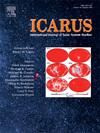Formation of steep-sided domes on Venus via eruption of high crystallinity magmas
IF 2.5
2区 物理与天体物理
Q2 ASTRONOMY & ASTROPHYSICS
引用次数: 0
Abstract
Steep-sided domes are distinctive volcanic landforms on Venus inferred to form by the eruption of highly viscous magma. However, mechanisms responsible for the formation of steep-sided domes remain unclear and the subject of debate. Here we use the rhyolite-MELTS algorithm to constrain the range of magma compositions produced by fractional crystallisation and remelting of Venusian crust, based on rock compositions derived from Venera 13 (alkaline basalt) and Venera 14 (sub-alkaline basalt) lander data. We then calculate liquid-only and liquid plus crystal magma viscosities and compare results to physical models which propose critical minimum viscosities required to form Venusian steep-sided domes. Extensive (>85–90 %) fractionation of Venera 13-based compositions results in the highest viscosity liquids in our models of 9.3 × 108 Pa·s. However, fractional crystallisation and crustal remelting alone is unable to produce liquids with viscosities required to account for formation of steep-sided domes. The intrinsic effect of H2O by acting as a network modifier in reducing liquid viscosity is more significant than the indirect increases in liquid viscosity caused by modifying phase relations and magma compositions, such as the increase in SiO2 content. Regardless, even if complete degassing of initially H2O-saturated magmas is invoked, modelled liquid-only viscosities are still insufficient to account for formation of steep-sided domes. Instead, we find that magmas with high crystal contents, typically >60 vol%, are required to produce sufficiently viscous magmas, a value relatively independent of liquid composition and viscosity parameterisation. Rare terrestrial examples of similarly crystal-rich lava flows and volcanic domes require processes such as rapid degassing-induced crystallisation or fault-controlled mechanisms to accumulate such high crystallinity.
高结晶度岩浆喷发形成金星上陡峭的圆顶
陡峭的圆顶是金星上独特的火山地貌,据推测是由高粘性岩浆喷发形成的。然而,负责形成陡峭圆顶的机制仍然不清楚,并且是争论的主题。本文基于金星13号(碱性玄武岩)和金星14号(亚碱性玄武岩)着陆器的岩石成分数据,利用流纹岩-熔化体(rhyolite- melt)算法来限制金星地壳部分结晶和重熔产生的岩浆成分范围。然后,我们计算了纯液体和液体加结晶岩浆的粘度,并将结果与提出形成金星陡峭圆顶所需的临界最小粘度的物理模型进行了比较。在我们的模型中,基于Venera 13的成分的广泛(85 - 90%)分馏产生了9.3 × 108 Pa·s的最高粘度液体。然而,单靠部分结晶和地壳重熔是无法产生粘度足以形成陡壁圆顶的液体的。H2O作为网络改性剂降低液体粘度的内在作用比通过改变相关系和岩浆成分(如SiO2含量的增加)间接增加液体粘度的作用更为显著。无论如何,即使对最初饱和的h2o岩浆进行完全脱气,模拟的纯液体粘度仍然不足以解释陡峭圆顶的形成。相反,我们发现具有高晶体含量的岩浆,通常为60 vol%,需要产生足够粘性的岩浆,这个值相对独立于液体成分和粘度参数化。地球上罕见的类似的富含晶体的熔岩流和火山圆顶需要快速脱气诱导结晶或断层控制机制等过程来积累如此高的结晶度。
本文章由计算机程序翻译,如有差异,请以英文原文为准。
求助全文
约1分钟内获得全文
求助全文
来源期刊

Icarus
地学天文-天文与天体物理
CiteScore
6.30
自引率
18.80%
发文量
356
审稿时长
2-4 weeks
期刊介绍:
Icarus is devoted to the publication of original contributions in the field of Solar System studies. Manuscripts reporting the results of new research - observational, experimental, or theoretical - concerning the astronomy, geology, meteorology, physics, chemistry, biology, and other scientific aspects of our Solar System or extrasolar systems are welcome. The journal generally does not publish papers devoted exclusively to the Sun, the Earth, celestial mechanics, meteoritics, or astrophysics. Icarus does not publish papers that provide "improved" versions of Bode''s law, or other numerical relations, without a sound physical basis. Icarus does not publish meeting announcements or general notices. Reviews, historical papers, and manuscripts describing spacecraft instrumentation may be considered, but only with prior approval of the editor. An entire issue of the journal is occasionally devoted to a single subject, usually arising from a conference on the same topic. The language of publication is English. American or British usage is accepted, but not a mixture of these.
 求助内容:
求助内容: 应助结果提醒方式:
应助结果提醒方式:


